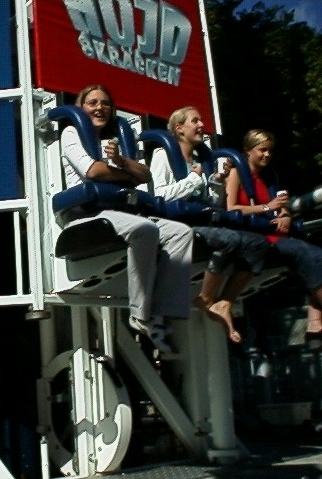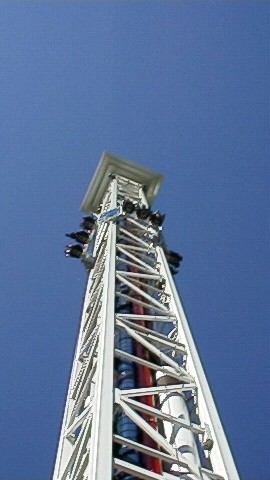
Newton in the amusement park
The first law obviuously applies to the girls waiting for the ascent the drop tower. They take along mugs with a little bit of water to examine the drop more closely. Newton's first law also applies during the slow ascent, even when you are high up, looking up and find that you have a l-o-n-g way to go.Newton's first law applies when you sit for 7 seconds at the top, enjoying the view - waiting to be shot down.
... because nobody visits an amusement park to experience uniform rectilinear motion.
Newton's second law
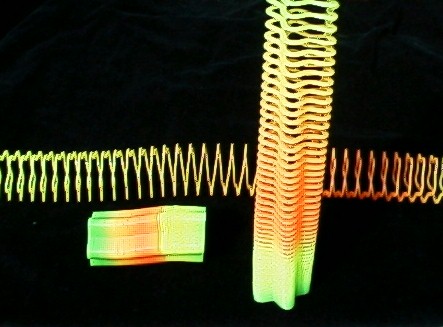 The ride can, of course also be studied using
electronics - for a show or a qualitative experience, a slinky gives
a stronger visual effect of vertical acceleration.
The ride can, of course also be studied using
electronics - for a show or a qualitative experience, a slinky gives
a stronger visual effect of vertical acceleration.
Two-dimensional motion
To study horizontal acceleration, a little cuddliy animal in a string works fine, combined with a protractor. You see how the rabbit falls behind as a I start moving. 10 degrees corresponds to an acceleration from zero to 50km/h in 8 seconds.
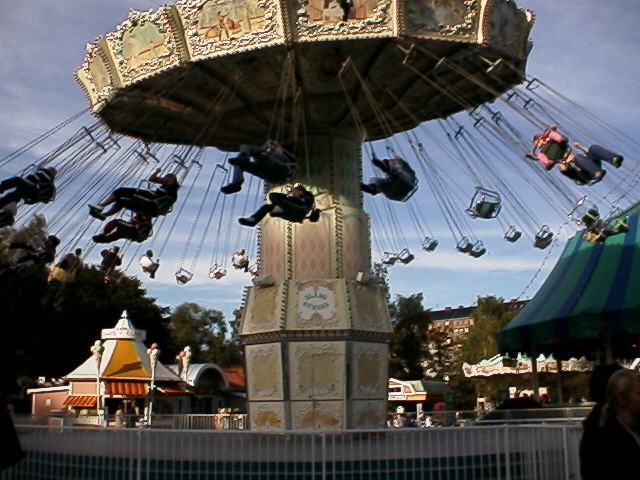 Most accelerations in an amusement park are much larger - like in the
"wave swinger".
Most accelerations in an amusement park are much larger - like in the
"wave swinger".
As you see the wave swinger start, take a moment to consider which swing will hang out the most - an empty swing or a heavily loaded one. Stay and watch - as all swings in the same circle hang out in the same angle. The equivalence principle in front of your eyes. Recall Eötvös who used the earth as a giant wave swinger, testing the equivalence principle!
Foucault
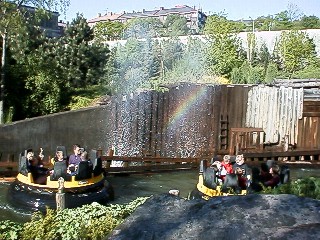 How can we know that the earth rotates? Because we have night and day?
People have known that long before they know the earth was rotating.
The critical experiment is, of course, Foucault's pendulum in Pantheon
in Paris. A miniature Foucault pendulum can be used to find out if it is
the platform or the ground that moves, as you finish the river rapids ride.
How can we know that the earth rotates? Because we have night and day?
People have known that long before they know the earth was rotating.
The critical experiment is, of course, Foucault's pendulum in Pantheon
in Paris. A miniature Foucault pendulum can be used to find out if it is
the platform or the ground that moves, as you finish the river rapids ride.
Roller coaster
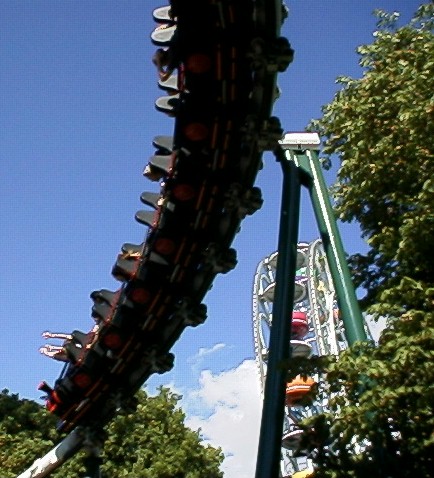 What is an amusement park without a roller coaster, where we
need three dimensions to describe the motion. In Liseberg, the natural
hills and valleys are used and the track is designed especially to fit
in. To work out the forces, we need to know the altitude relative to the
highest point, the slope along the track and sideways, as well as the
curvature sideways and up/down. So every part of the track is numbered
and has these parameters well-defined.
What is an amusement park without a roller coaster, where we
need three dimensions to describe the motion. In Liseberg, the natural
hills and valleys are used and the track is designed especially to fit
in. To work out the forces, we need to know the altitude relative to the
highest point, the slope along the track and sideways, as well as the
curvature sideways and up/down. So every part of the track is numbered
and has these parameters well-defined.
Take your rabbit-on-a-string along to find out at what parts of the track you are weightless, and how the rabbit moves along the curves and down the slopes. Does it matter what seat you choose?
Point particles
 In an amusement park, the approximation of a point particle becomes
obviously irrelevant. Your body will certainly know the difference
between a circular motion where you head stays upright, and one where it
doesn't. What happens to your blood in this attraction?
In an amusement park, the approximation of a point particle becomes
obviously irrelevant. Your body will certainly know the difference
between a circular motion where you head stays upright, and one where it
doesn't. What happens to your blood in this attraction?

What happens in a loop?
And what happens as your body experiences rotations around various axes? What is up? What is down? An amusement park is a large laboratory, ready to use!When you do physics in an amusement park, you are in good company - Einstein gave a talk in Liseberg in 1923.
